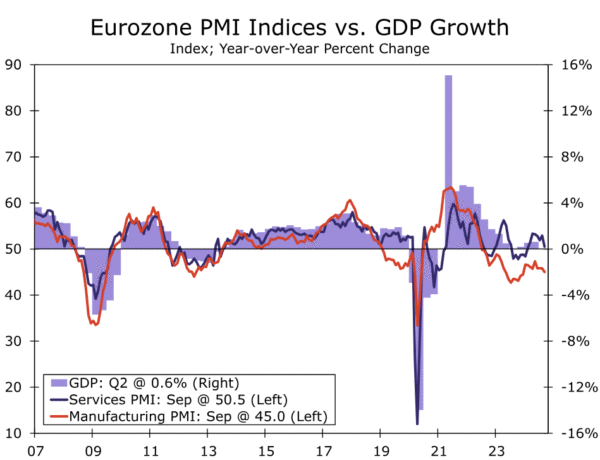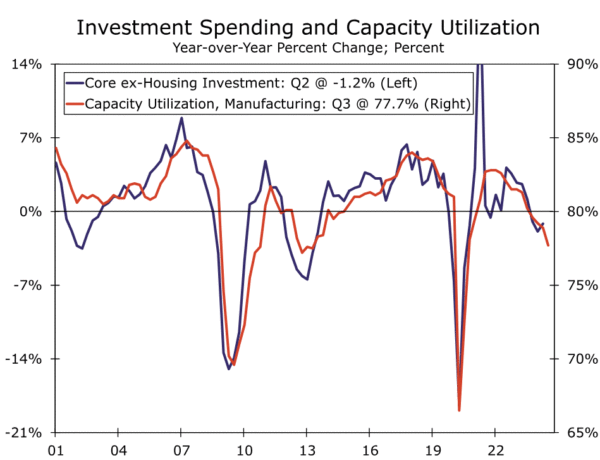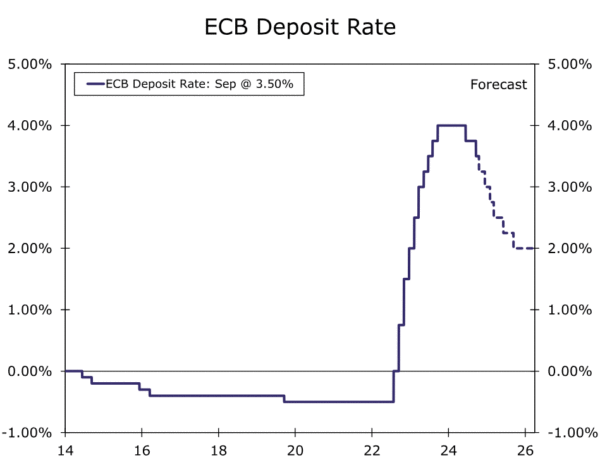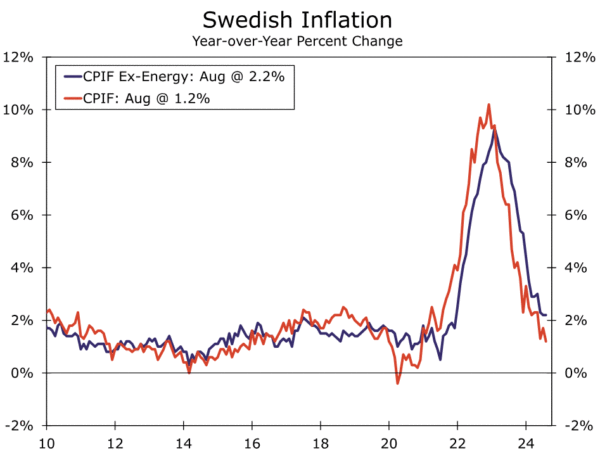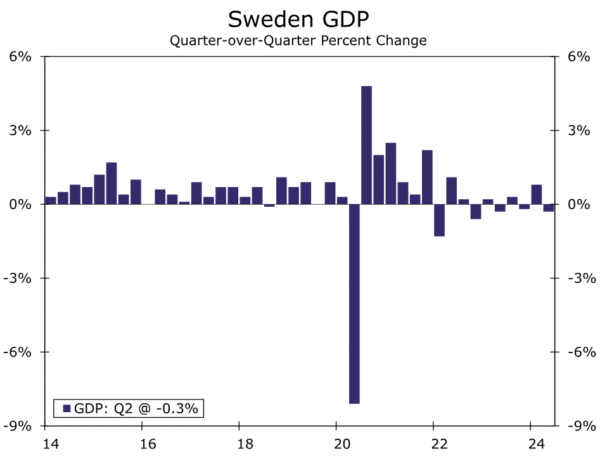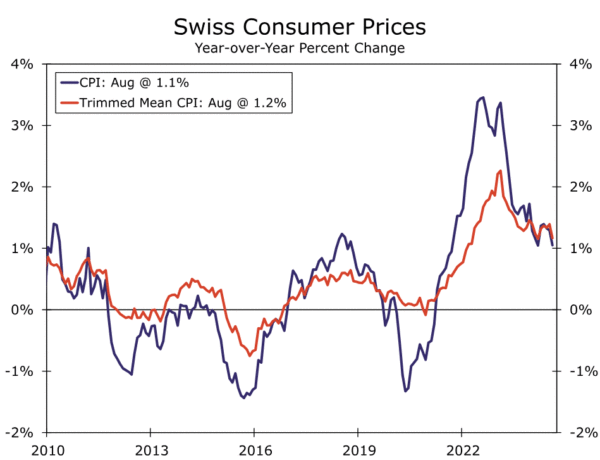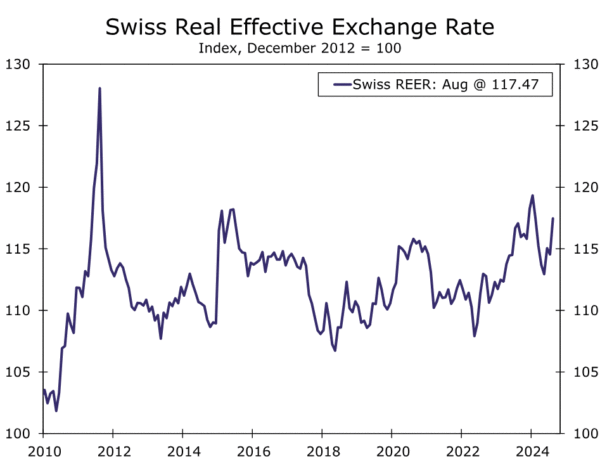Summary
- The European Central Bank (ECB) initially adopted a cautious and gradual approach to rate cuts during the early stages of its monetary easing cycle. However, given some deterioration in sentiment surveys, evidence of subsiding inflationary pressures, and recent benign comments from ECB President Lagarde, we now expect a more regular pace of rate cuts from the ECB over the next several months.
- We look for the ECB to cut rates by 25 bps at its October 2024, December 2024, January 2025 and March 2025 announcements. As ECB policy rates move closer to a neutral level, we see the central bank paring back the pace of its rate cuts to a quarterly frequency. We see the ECB cutting interest rates by 25 bps at the June 2025 and September 2025 meetings, bringing its policy rate to a low of 2.00% by late next year.
- The Riksbank is also set to ease monetary policy at a faster pace, after it cut its policy rate last week by 25 bps to 3.25%, lowered its growth and inflation forecasts, and offered dovish policy guidance in its accompanying statement. Soft data and dovish guidance means we now see a 50 bps rate cut in November, and with regular 25 bps rate cuts at each meeting thereafter, we expect the Riksbank’s policy rate to reach a low of 2.00% by the end of Q1-2025.
- The Swiss National Bank (SNB) lowered its policy rate by 25 bps to 1.00% last week, while also noting a significant reduction of inflationary pressures and a recent strengthening of the Swiss franc. Given the potential for further franc gains against a backdrop of European Central Bank (and Federal Reserve) easing, and given the subdued outlook for Swiss inflation, we now expect the SNB to ease monetary policy further, and forecast a 25 bps rate cut in the SNB’s policy rate, to 0.75%, at its December monetary policy announcement.
European Central Bank To Step Up The Pace Of Rate Cuts
During the early stages of its rate cut cycle, the European Central Bank (ECB) has adopted a cautious and gradual approach toward monetary easing. Given lingering concerns about elevated wage growth and persistent services inflation, the ECB lowered its policy rate 25 bps in June, paused in July, and delivered another 25 bps rate cut in September, bringing its Deposit Rate to 3.50%. However, with recent data pointing toward weaker growth and softening inflation, we believe the ECB is likely to pursue a more regular pace of rate cuts over the next several months. We expect the European Central Bank to lower its policy rate by 25 bps at every meeting through March of next year, before reverting to a quarterly pace of rate cuts thereafter. That would lower the ECB’s Deposit rate to a terminal rate of 2.00% by September 2025.
After enjoying a moderate rebound in economic growth during the first half of this year, Eurozone expansion appears to be losing momentum during the second half of 2024. The ECB has increasingly indicated at recent announcements that risks to economic growth are tilted to the downside. That message was reinforced with the release of the Eurozone PMI surveys for September. The manufacturing PMI fell to 45.0, the lowest level since December of last year, with German manufacturing remaining especially weak. Meanwhile, the services PMI dropped much more than expected to 50.5, the lowest level since February, in part as the French services PMI reversed an Olympics-related boost seen in August. Combining both the manufacturing and services sector, the composite (or economy-wide) PMI dropped to 48.9 in September, which was also the first reading in contraction territory since February this year. In addition to the disappointing headline figures, the details of the PMI reports were also discouraging. The manufacturing PMI showed a softening in new orders and order backlogs, while the services PMI showed a softening in incoming new business.
The “hard” activity data, although a bit more dated, are similarly weak with growth in retail sales volumes (-0.1% year-over-year) and industrial output (-2.2% year-over-year) both in negative territory in July. Finally, in terms of fundamental growth drivers, while gains in real household disposable income should support modest gains in consumer spending over time, falling net entrepreneurial income (a proxy for corporate profits) and declining capacity utilization suggest a retrenchment in investment spending. Against this backdrop we recently revised our Eurozone GDP growth forecasts lower to 0.7% for 2024 and 1.2% for 2025, though the risks are arguably still tilted to the downside.
In addition to the downside risks to growth, there are more encouraging signs that Eurozone inflation pressures are ebbing. The Eurozone September PMI surveys were also notable for a reported softening in input costs and output prices. That comes on the back of slower wage growth reported for Q2-2024, as the ECB’s Indicator of Negotiated Wages slowed to 3.6% year-over-year and Compensation per Employee slowed to 4.3%. Importantly, those signals of reduced price pressure were also confirmed by the Eurozone September CPI. Headline inflation slowed to 1.8% year-over-year, below the ECB’s inflation target for the first time since June 2021, while core inflation also eased to 2.7%, as did services inflation, to 4.0%.
The worsening growth outlook along with ebbing inflation pressures will, we think, provide ECB policymakers with enough comfort to once again lower interest rates at their October monetary policy announcement. Indeed, some recent dovish comments from ECB President Lagarde to the European Parliament appear consistent with that view. Lagarde said that disinflation has accelerated in the last two months, that the “latest developments strengthen our confidence that inflation will return to target in a timely manner,” and that we “will take that into account in our next monetary policy meeting in October.” In addition, sentiment surveys suggest the news on economic growth is likely to get worse before it gets better, while over time we would also expect wage growth and underlying inflation trends to continue a gradual deceleration. Against this backdrop, we expect a steady series of ECB rate cuts in the months ahead. We look for the ECB to cut rates by 25 bps at its October 2024, December 2024, January 2025 and March 2025 announcements. As ECB policy rates move closer to a neutral level, and as growth in economic activity perhaps starts to stabilize, we see the central bank paring back the pace of its rate cuts to a quarterly frequency. We see the ECB cutting interest rates by 25 bps at the June 2025 and September 2025 meetings, bringing its policy rate to a low of 2.00% by late next year.
Sweden’s Riksbank To Also Get A Move On
The European Central Bank is not the only central bank for which we are now forecasting a faster pace of easing; Sweden’s Riksbank also makes the list. Underpinning our outlook for more timely Riksbank easing, last week the central bank cut its policy rate by 25 bps—for the 3rd time this year—to 3.25%, and communicated an overall dovish stance. In explaining the case for the rate cut, policymakers pointed to a fall in inflation pressures over the year. Officials also noted how they have shifted their concern from primarily price pressures, to economic activity, stating that the economy has been recovering at a slower pace than previously expected. The announcement also included more dovish updated forward guidance, with policymakers stating that “the policy rate can be cut at a faster pace than the Riksbank has previously communicated”. More specifically, if the outlook for prices and GDP growth remains unchanged, policy rate reductions can also be delivered at the November and December meetings, and most significantly, they signaled that there could be a 50 bps rate cut at a coming meeting. The Riksbank also added that one or two additional cuts could come in the first half of next year. Overall, this announcement was consistent with the general trend of increasingly dovish forward guidance from the Riksbank that we have seen over the course of this year.
When looking at the data from recent months, it is not surprising, in our view, that the Riksbank has continuously inched in a more dovish direction. CPIF inflation has continued to slow, coming in at just 1.2% year-over-year in August—below the central bank’s 2% target for the measure. Underlying price pressures measured via the CPIF excluding energy have also largely abated, having slowed from an above-4% year-over-year pace at the beginning of 2024 to 2.2% year-over-year in August. Nominal wage growth in Sweden—an area of concern for many other global central bankers amidst their respective battles against inflation—has also slowed consistently since the early part of this year. Meanwhile, GDP growth has also been subdued, with the Swedish economy having contracted on a quarter-over-quarter basis for four out of the past seven quarters, while the unemployment rate has also trended upward over the past year. This softer picture for price pressures and economic growth was also reflected in the Riksbank’s updated economic projections published last week. The central bank downwardly revised its CPI and CPIF inflation forecasts for this year and next, and downwardly revised its GDP forecast for 2024, to 0.8% from 1.1% previously.
Looking ahead, we believe that the trend will remain for subdued inflation and economic growth data in the near term. In our view, an outlook for softer inflationary pressures coupled with more subdued economic growth justify a faster pace of easing from the Riksbank. In addition to domestic economic data, we believe actions by other major central banks, specifically the ECB and Federal Reserve, will help Riksbank policymakers feel comfortable adopting a more accelerated easing approach. The Fed started its easing cycle with a bang in September with a 50 bps rate cut, and we now also expect the ECB to pick up the pace of its easing to a 25-bps-per-meeting rate cut pace over the next several meetings. Taking together the considerations of near-term subdued price pressures and economic growth, downgrades to the Riksbank’s inflation forecasts and dovish forward guidance, along with other major central banks likely adopting a more hastened pace of rate cuts, we have adjusted our outlook for Riksbank monetary policy to include a faster pace of easing than previously expected. Near-term softness in the data and central bank signals lends itself, in our view, to a 50 bps rate cut at the Riksbank’s November meeting. After that, we see the central bank delivering 25 bps rate cuts at each meeting through the end of Q1-2025, to reach a policy rate of 2.00%. As the fairly aggressive pace of easing we expect to see through year-end 2024, and further easing in early 2025, helps the central bank to approach a neutral policy rate and helps Sweden’s economic recovery to gain steam, we see the Riksbank pausing its easing cycle once the policy rate reaches 2.00% in the early part of next year.
Swiss National Bank Likely To Cut Rates Again In December
The Swiss National Bank (SNB) was another central bank to offer a dovish perspective at its monetary policy announcement last week. The SNB lowered its policy rate by 25 bps to 1.00%, matching widespread expectations. The SNB said inflationary pressures in Switzerland had decreased significantly compared to the previous quarter, reflecting among other things the appreciation of the Swiss franc over past three months. Indeed, even incorporating the latest rate cut, the central bank significantly lowered its medium-term inflation forecast, reflecting the strength of the franc, lower oil prices and announced electricity price cuts, as well as weaker second-round price effect given lower headline inflation. The central bank’s updated forecast is within the SNB’s price stability range over its entire forecast horizon, envisaging annual inflation of 1.2% for 2024, 0.6% for 2025 and 0.7% for 2026.
Considering the benign inflation outlook, the SNB said further cuts in the policy rate may become necessary in the coming quarters to ensure price stability over the medium term. Given our outlook for more accelerated European Central Bank interest rate cuts, we see increased potential for further appreciation in the Swiss franc—a currency that is already at historically elevated levels as measured on a real effective exchange rate basis. Accordingly, given the likelihood of further franc gains against a backdrop of European Central Bank (and Federal Reserve) easing, and given the subdued outlook for Swiss inflation, we now expect the SNB to ease monetary policy further, and forecast a 25 bps rate cut in the SNB’s policy rate, to 0.75%, at its December monetary policy announcement.




